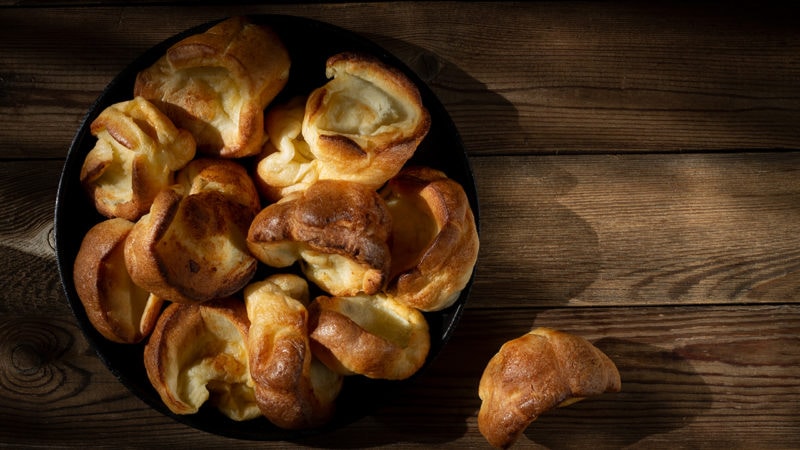Last Updated on February 28, 2024
In my former life as a teacher, the holidays brought an array of annual traditions: Kids becoming progressively manic as holiday break approached, massive school-wide caroling concerts, and the faculty Christmas dinner. It was at my first annual dinner spread that I first came across the holiday treat that to that point, I hadn’t known even existed.
As I passed a tray of strange-looking popover type of dish, the teacher behind me hit me in the back, “You’re not going to have any Yorkshire pudding?”
“What…pudding?” I responded.
Before I knew it, I had a fluffy, plate-encompassing roll plopped on my plate. Sitting down, I dug into the delectable side for the first time in my life. “What is this? And why had I never heard of it until now?” I wondered.
Hot rolls, croissants, french loaves, various fruit breads, biscuits, a litany of bread-wrapped side dishes. All of these had made an appearance at a holiday meal growing up, but never even a mention of Yorkshire pudding — the airy bread muffin made with the drippings of the beef main dish.
My question, at this point, is why Yorkshire pudding doesn’t pop up on more holiday tables in America. The recipe is relatively easy, it is a side dish that is a bread product, and, these popovers are delicious.
First, the name Yorkshire pudding
Yorkshire pudding is not, in fact, a pudding as we think of it in the modern sense. This was my first surprise when discovering both the dish and its moniker.
Pudding is a term long used in the United Kingdom and Ireland, to denote either a sweet or savory dish that combines meat or other ingredients in a sausage-like or liquid form and a binding agent — grain, rice, etc. — that is baked, broiled, or steamed. Examining the wide range of foods that use pudding as a descriptor helps to understand how we get from the pastry-like Yorkshire pudding to the sausage like black pudding — often called black pudding— traditional in Ireland and the Scottish dish haggis. The leap to the American and Canadian usage of pudding to signify a sweet, dairy dessert, can be traced to the evolution from rice puddings, bread pudding, and the Christmas-tradition of figgy pudding to custards, crème brûlée, mousse, and eventually the Jell-O version found in stores today.
This is why when discussing writing a piece on Yorkshire pudding as a side dish for a Christmas roast, a few younger staff members recoiled in horror at the idea of pudding on a plate with a juicy slice of New York strip roast.
History of Yorkshire pudding
If you haven’t realized yet, Yorkshire pudding has its roots in England. It was first recorded in a few domestic home-keeping guides from the early 1700s, and, even today, it brings up memories of Dickens, A Christmas Carol, and Victorian London.
The traditional British dish was first recorded in the antiquatedly titled, The Whole Duty of the Woman. The book describes cooking the bread “pudding” by placing it under the main hunk of meat — mutton in this instance — to collect the dripping while cooking in the hearth. The New York Times refers to it coming from “an era when an English pub might cook a hunk of meat by dangling it from a hook above a roaring fire. The “pudding” emerged from a pan full of runny batter that would have been placed beneath the meat to soak up the juices.”
The dish is still a staple of the traditional Sunday meal and holidays across England to this day.
Yorkshire pudding recipes
There are a bunch of great Yorkshire pudding recipes out there. NYT Cooking has a great, simple recipe as do The Food Network’s Taylor Florence and Gordon Ramsay — but most are relatively easy, to be honest.
Basically, an amazing Yorkshire pudding can be made with about four to five ingredients in under an hour. Combine flour, milk, 3 eggs, and salt — equal parts flour and milk, about 3/4 of a cup and half to a full teaspoon of salt. The key is adding the hot pan drippings from whatever main dish you are also making, like roast beef or pork. You can also substitute olive oil or butter, but a true Yorkshire pudding is built on the fatty and flavorful pork or beef drippings.
The hot dripping cooks with the batter as it rises to create a delicious, fluffy accompaniment to any holiday main dish. Many suggest letting the batter sit at room temperature for at least half an hour before cooking. Also, there are various methods for adding the drippings: You can heat first in a muffin tin and then add batter or warm batter for a few minutes and then add hot drippings and finish cooking.
I guarantee that once you have a perfect Yorkshire pudding, you’ll wonder why you’ve been deprived of the amazing dish for so many holidays.
Dennis Keohane is a writer, editor, and former Editorial Director for ButcherBox with a passion for storytelling and food. Combining his love for high-quality ingredients with engaging narratives, he crafts content that inspires home cooks to explore new flavors, techniques, and the joy of cooking.




